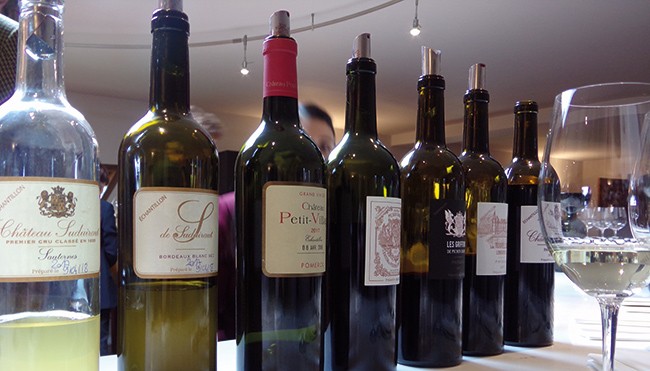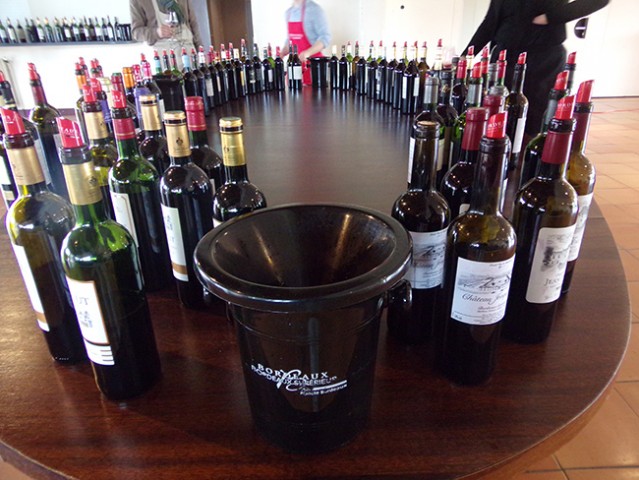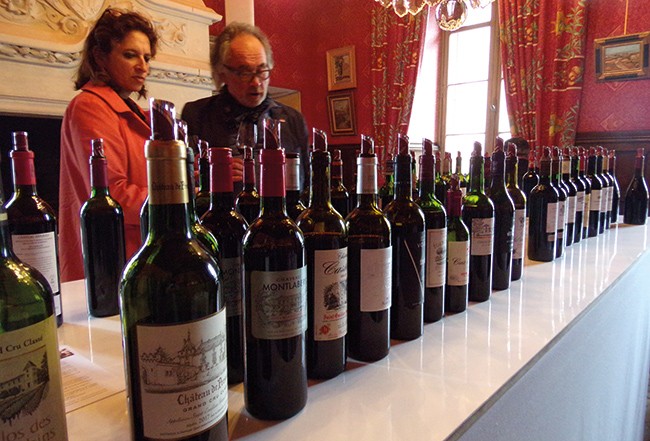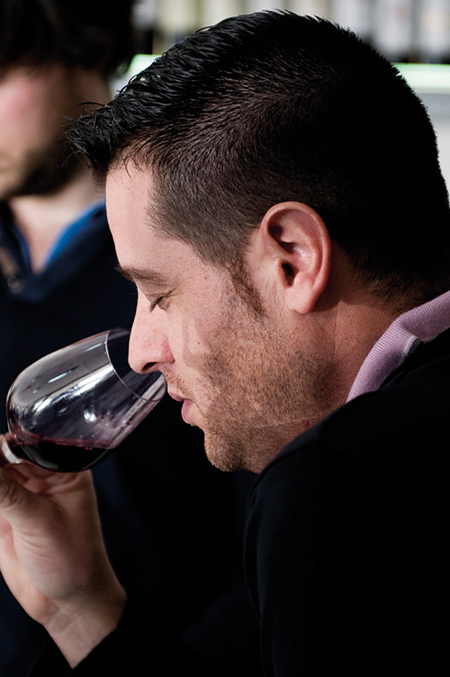The rise in temperature in the end of the winter favoured early budburst and a particularly dry April resulted in a very rapid growth. The frost in the plains on April 21 and 22 and the hard frost on April 27 and 28 severely disturbed the early growth of full and large bunches. On the plots that have been saved, a dry and warm May enabled homogeneous and regular blooming. One could notice, on the harder hit plots, that two generations of bunches had to be considered. Precondition to a homogeneous harvest. The storms in spring stimulated the ripening. The heat in the end of the summer favoured the level of sugar and tannin maturity. According to Simon Blanchard from Derenoncourt Consultant, it remains “difficult to define this vintage since it is heterogeneous, the seriousness of the wine grower’s work was essential once again this year”. The Semillons, Sauvignons and Muscadelles harvested early globally show a good maturity and give expressive and aromatic wines. The sweet wines show a lot of freshness and vigor with lovely acidity-sugar balances.
For this vintage marked by the bites of the frost in April, the producers had indeed to favour light élevage and soft extractions to emphasize on fruitiness.

The deadly series of frost episodes on April 21, 22, 28 and 29, followed by hail in Podensac, of course resulted in an uneven vintage. We can notice significant differences between the area of Portets, less affected by the frost, and the south of the appellation much more impacted by the weather events. The dry beginning of the season with temperatures 1.5°C higher on average and the early development of the vine was of good omen in many aspects. As explained by president Dominique Guignard, it has been “at the very least a difficult vintage that had to be worked to go and seek the tannins”. He adds “it has certainly been easier to make fine wines in great vintages” referring to the overused but right notion of “wine growers’ vintage”. The wines are pleasant to taste with aromas coming up quickly and the omnipresence of fruits as long as the second shoots more fragile and vegetal have not been integrated. Château de Cérons in red is a perfect example of this vintage as it already presents expressive floral aromas and a fresh and tonic palate, though a bit light. This terroir in Graves usually giving graceful and delicate white wines reveals some tense and very fresh wines like Château de Sauvage or the aromatic Château Chantegrive Cuvée Coraline who managed to deal with this vintage despite disrupted and Semillon-focused blends, unveiling a wine with aromas of ripe and exotic fruit.

On these usually cold lands the harvest sometimes started round September 25th in order to wait for the late Cabernet Sauvignons. Although the earliness of the vintage has been evoked especially about the flowering and ripening, the strong rainfall in late September after a dry summer finally interfered with the good maturity of the vintage. In general, the Merlots have been scarcely impacted by the frost, something that questioned the blends of some red Pessac-Leognans. In the best cases, the production, not very homogenenous, offers fresh and fruity red wines, less rich than fine and finally fairly close to the characteristics of the AOP. In red Château Larrivet Haut Brion shows lightness and proposes a fresh palate, barely tickled by tonic tanninsc.With a sometimes more important part of Sémillon like in Château Latour Martillac, the whites from the AOP show off excellent aromatic ranges, tending towards ripe citrus or even exotic fruits. In white, also reminf Château Larrivet Haut-Brion and its 75% of Sauvignon that surprises by its aniseed and floral aromas with a sweet finish.
Planète Bordeaux invited some 50 producers to present their wines during the En Primeurs campaign. Let’s remind that the frost in April reduced the crop by 40% compared to last year, resulting in a total production of 3.5 million hectolitres all productions taken together.
Those who succeeded in this difficult vintage in the Bordeaux and Bordeaux Supérieur appellations are the wine growers who were committed to work the fruitiness, therefore careful to operate soft extractions and cautious élevage, favouring the balance between new and one-year-old barrels. The quality of this vintage was also the result of a meticulous work in the vineyard. Enologist Antoine Médeville reminded that “the wine growers had to handle with the picking dates, be careful to the maturity controls, divide the plots in two and adapt the vinifications”.
The Sauvignons have been picked as from August 21st and the Semillons until early September. These white wines harvested in good conditions are fresh and show a very nice aromatic breadth and lovely acidities. Finally, the red Bordeaux, harvested early, between the beginning and the middle of September, show a lot of vividness. Some red wines stand out by their beautiful balance like Château Jean Faux in Bordeaux Supérieur. The nose of this wine is complex and the palate delicately creamy. A sure bet of this extended appellation. Also try Domaine de Courteillac, Bordeaux Supérieur, with its very floral nose and perfectl balanced and moreish palate.

Here too, the 2017 vintage boded very well in the Libourne area until the frost in April. THe latter especially hit the north of the appellation and the foothills – to be noted that the appellation has a 100-meter difference of altitude in some zones. The productioon registered losses of 40 to 90% with yields ranging from 8 to 40 hectoliters per hectare for the luckiest.
The plots, carefully sorted during meticulous picking, to leave the young shoots of second generations, give very fruity wines with excellent maturities and silky tannins. Those who succeeded indeniably owe it to the care given to the élevage and the blends often disturbed by the frost. A wine to seek out, Domaine de l’A, on a clay and limetone plateau, with a tense palate evolving towards beautiful lively tannins. Or Château Moya with its powerful palate and fresh fruit in the finish.
Is it necessary to remind that the 2017 vintage was born in a vdery peculiar weather context with water stress and temperatures higher than average in the beginning of the year which led to early budburst and dangerously exposed the buds to late frost.
The southern side of Saint-Emilion, with a good exposure, has been quite preserved from the frost whereas the northern slopes have been more impacted. The clay and limestone plateaus of Pomerol have often avoided the drubbing. THe areas of Puisseguin and Lussac have been more affected. However the 2017 En Primeurs wines in Saint-Emilion Grand Cru, Saint-Emilion, Montagne, Lussac and Puisseguin often offered very lovely wines, whose fruitiness and freshness compensate a certain lack in material. Eric Jeanneteau from Château Tertre de la Mouleyre chose to use only 35% of new barrels. An option that enbled him to craft an elegant Saint-Emilion Grand Cru built on lively tannins and complex fruitiness and aromas. The true profile of this vintage second to no other before, not even to the frightful 1991, is that of a barely tannic and fresh wine. A freshness that we find in Château Clarisse Vieilles Vignes, in Puisseguin Saint-Emilion but also in Château de Candale, Saint-Emilion Grand Cru with a fresh nose of backcurrant blossom and juicy red fruits on the palate.
President of the Association of Enologists of Bordeaux
“Despite the frost that hit Saint-Emilion, I think the wines presented do quite well. Though heterogeneous, the wines stemming from frozen vines are pleasantly vivid and on the edge whereas the non frozen vines present an incredible material and a beautiful maturity.”
The left bank of the Garonne river as a whole enabled the Cabernet Sauvignon to reach good levels of maturity that – as mentioned by Fabien Faget from enology consultancy firm Enosens – have given, especially in the north of the Medoc, notes of black fruits and spices. Less well-balanced structures are to be found in the south. This vintage is characterized by its earliness in the areas close to the estuary and spared by the frost with “excellent potential and beautiful fruity expressions” according to Fabien Faget. The Haut-Medoc Château Malescasse expresses a beautiful aromatic intensity with notes of elderberry and blackberry jam. On the palate, the first taste is fresh and the fine tannins open the way to notes of fresh morello cherries. A real success. Other notable wine, Château La France Delhomme, Cru Bourgeois from Médoc, 100% Merlot, that present a very velvety palate with very lovely ripe fruits.
President of the Medoc Wines Committee
“For the lucky ones who have not suffered from the frost, 2017 is pleasant, full and well-balanced. A bit as if the vines spared by the frost answered to the violence of the weather with an extreme softness, a very pleasurable character! This original vintage will have to be registered in our books anyway.”
Thanks to its proximity with the river, temperature controller, Saint-Estèphe has been widely spared by the frost in April. The Merlots on hilltops were ready ten days in advance and as a whole they showed excellent maturities. Though the structure of Château German Marbuzet Saint-Estèphe is not powerful, we can admire its elegance and finesse. In Pauillac, the fresh and humid conditions of the last fifteen days of September changed the profile of the vintage. The early Merlots have been harvested together with the Cabernet Sauvignons, picked with good phenolic qualities. In this appellation, seek out Château Pichon Baron who combines powerfulness and finesse with an already perfectly unctuous and sappy.
Henry Clémens

Derenoncourt Consultant
“The vintage is early and maturity is there but with a rainy and stormy September. WE thus get fine wines, with a refined tannic structure and beautiful aromatic intensities. It is difficult to mention an appellation especially standing out ; you rather have successes a bit everywhere, but in general the wines stemming from clayey soils (limestone or gravelly) better absorbed the rains of September and present less dilution in the mid-palate. On the contrary the light soils often produced wines lacking body".